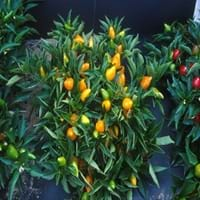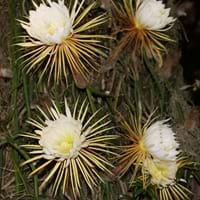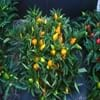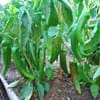Life Span
Annual
Perennial
Type
Vegetable
Cactus, Flowering Plants
Origin
Mexico, Central America, South America
South America, Argentina, Brazil
Types
red bell pepper, yellow bell pepper, green bell pepper
Not available
Habitat
Open areas
Dry Forest, limestone outcrops, Subtropical climates
USDA Hardiness Zone
Not Available
10-14
Sunset Zone
A1, A2, A3, H1, H2, 1a, 1b, 2a, 2b, 3a, 3b, 4, 5, 6, 7, 8, 9, 10, 11, 12, 13, 14, 15, 16, 17, 18, 19, 20, 21, 22, 23, 24
H2, 13, 16, 17, 21, 22, 23, 24
Habit
Oval or Rounded
Upright/Erect
Flower Color
White
White, Light Green
Flower Color Modifier
Bicolor
Bicolor
Fruit Color
Yellow, Red, Green, Purple, Orange, Light Yellow, Chocolate, Ivory
Orange, Pink, White, Yellow
Leaf Color in Spring
Green
Not Available
Leaf Color in Summer
Dark Green
Not Available
Leaf Color in Fall
Dark Green, Black
Not Available
Leaf Color in Winter
Not Available
Not Available
Leaf Shape
Elliptic
Not Available
Plant Season
Spring, Summer, Fall
Spring, Summer, Fall, Winter
Sunlight
Full Sun
Full Sun
Type of Soil
Loam
Loam, Sand
The pH of Soil
Neutral
Acidic, Neutral, Alkaline
Soil Drainage
Well drained
Well drained
Bloom Time
Indeterminate
Late Spring, Early Summer
Tolerances
Drought
Drought, Salt
Where to Plant?
Container, Ground, Pot
Container, Ground
How to Plant?
Seedlings, Transplanting
Cuttings
Plant Maintenance
Medium
Medium
Watering Requirements
Do Not over Water
Average Water Needs, Distilled Water, Needs good drainage
In Summer
Lots of watering
Lots of watering
In Spring
Moderate
Moderate
In Winter
Average Water
Average Water
Soil pH
Neutral
Acidic, Neutral, Alkaline
Soil Type
Loam
Loam, Sand
Soil Drainage Capacity
Well drained
Well drained
Sun Exposure
Full Sun
Full Sun
Pruning
Remove damaged leaves, Remove dead leaves, Remove shoots
Remove damaged leaves, Remove dead branches, Remove dead leaves
Fertilizers
fertilize in growing season, Requires high amount of nitrogen
All-Purpose Liquid Fertilizer
Pests and Diseases
Anthracnose, Bacteria wilt, Bacterial leaf spot, Cercospora leaf spot, Powdery mildew, Red blotch
Bacterial Stem Rot, Mealy bugs, Red spider mite, Scale
Plant Tolerance
Salt
Drought
Flowers
Insignificant
Showy
Flower Petal Number
Single
Semi-Double
Foliage Texture
Medium
Bold
Foliage Sheen
Glossy
Not Available
Attracts
Not Available
Birds, Spider Mites
Allergy
Hives, Rash
Avoid during Pregnancy, hallucinations
Aesthetic Uses
Showy Purposes
Showy Purposes
Beauty Benefits
Good for skin, Good for skin and hair, Improve hair condition, Improve skin condition, Improve skin tone
Not Available
Environmental Uses
Air purification, Food for animals, Food for insects
Air purification
Medicinal Uses
cholesterol-lowering, Low calories, Vitamin C
Antidiabetic, Rheumatism, Soothing and relieving pain
Part of Plant Used
Fruits
Flowers, Leaves
Other Uses
Used As Food
Traditional medicine, Used for its medicinal properties, Used in herbal medicines
Used As Indoor Plant
No
Yes
Used As Outdoor Plant
Yes
Yes
Garden Design
Bedding Plant, Container, Edible, Herb / Vegetable, Mixed Border, Tropical
Container, Edible, Hedges, Houseplant, Rock Garden, Wall, Tropical
Botanical Name
CAPSICUM annuum
Selenicereus grandiflorus
Common Name
Pepper
Queen of the night, large-flowered cactus, sweet-scented cactus, vanilla cactus
In Hindi
शिमला मिर्च
रात की रानी
In German
Capsicum
Königin der Nacht
In French
Capsicum
Reine de la nuit
In Spanish
Pimiento
Reina de la noche
In Greek
Κοκκινοπίπερο
Βασίλισσα της νύχτας
In Portuguese
cápsico
Rainha da noite
In Polish
papryka
Królowa nocy
In Latin
Capsicum
Domina noctis
Phylum
Magnoliophyta
Magnoliophyta
Class
Magnoliopsida
Magnoliopsida
Order
Solanales
Caryophyllales
Family
Solanaceae
Cactaceae
Genus
Capsicum
Selenicereus
Clade
Angiosperms, Asterids, Eudicots
Angiosperms, Core eudicots, Eudicots
Tribe
Capsiceae
Hylocereeae
Subfamily
Solanoideae
Cactoideae
Season and Care of Capsicum and Queen of the Night
Season and care of Capsicum and Queen of the Night is important to know. While considering everything about Capsicum and Queen of the Night Care, growing season is an essential factor. Capsicum season is Spring, Summer and Fall and Queen of the Night season is Spring, Summer and Fall. The type of soil for Capsicum is Loam and for Queen of the Night is Loam, Sand while the PH of soil for Capsicum is Neutral and for Queen of the Night is Acidic, Neutral, Alkaline.
Capsicum and Queen of the Night Physical Information
Capsicum and Queen of the Night physical information is very important for comparison. Capsicum height is 15.20 cm and width 20.30 cm whereas Queen of the Night height is 300.00 cm and width 90.00 cm. The color specification of Capsicum and Queen of the Night are as follows:
Capsicum flower color: White
Capsicum leaf color: Green
Queen of the Night flower color: White and Light Green
- Queen of the Night leaf color: Not Available
Care of Capsicum and Queen of the Night
Care of Capsicum and Queen of the Night include pruning, fertilizers, watering etc. Capsicum pruning is done Remove damaged leaves, Remove dead leaves and Remove shoots and Queen of the Night pruning is done Remove damaged leaves, Remove dead branches and Remove dead leaves. In summer Capsicum needs Lots of watering and in winter, it needs Average Water. Whereas, in summer Queen of the Night needs Lots of watering and in winter, it needs Average Water.





